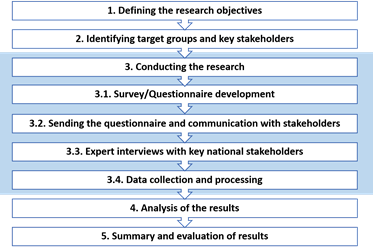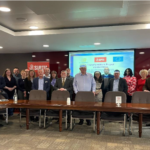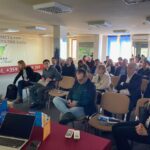As envisaged in the “Structure and methodology of National reports” the national research activities are divided in three stages. While the first stage focusses on desk research of relevant literature, the second stage will gather information through an online survey and expert interviews with key national stakeholders. The third stage comprises all research findings and provides recommendations towards the implementation of the Framework agreement.
Target groups: When analyzing key stakeholders ‘opinion it is worth noting that social dialogue can be happen at different levels (national, sector and enterprise level). Thus, it is important to observe the following groups:
- Cross-industry and sector-level trade union officials
- Cross-industry and sector-level employers’ organisations
- Government and local authority officials
- Company-level partners including managers, HR officers and shop stewards
- Academic experts.
Following the Objectives of Work- package 2 and the Framework structure and content of the national reports, the presented Analytic Framework for Stage 2 describes the overall content, research rationale, structure, volume, targeted groups and methodology description of the forthcoming online survey and expert interviews.
Content: Described and assessed strategies, methodologies and practices of the social partners related to the four main issues introduced by the European Social Partners’ Framework Agreement on Digitalisation. Assessment of the (bipartite and tripartite) social dialogue as a means for optimizing the benefits of digitalization while dealing with its challenges.
Research rationale: It is important to describe and assess the practices related to the four main issues introduced by the Framework Agreement with regard to the digitalizing world of work:
- Digital skills and securing employment
- Modalities of connecting and disconnecting
- Artificial Intelligence (AI) and guaranteeing the human in control principle
- Respect of human dignity and surveillance.
Social dialogue will be assessed as to whether support all of the above-mentioned issues introduced by the Framework Agreement. Thus, analysis will outline both challenges and opportunities when digital transformation is negotiated between the social partners at different levels.
Structure: By using (open-ended and closed) questions related to the four main issues introduced by the Framework Agreement, the research activities will collect information concerning:
- Digital skills and securing employment: the process of determining which (digital, soft, social) skills and change of processes are necessary to be introduced and, in consequence, organization of adequate training measures; involvement of social partners at the appropriate level, as well as HR and line-managers and workers’ representatives and (European) works councils, in motivating staff to take part in training, creating frameworks based on open communication, and in information, consultation and participation; access to and arrangements of training.
- Modalities of connecting and disconnecting: provision of guidance and information for employers and workers on how to respect working time rules and teleworking and mobile work rules; policies and/or the agreed rules on the use of digital tools for private purposes during working time; alert and support procedures to find solutions and to guard against detriment for workers for not being contactable; exchanges between managers and workers and/or their representatives on the workload and integration in the work processes.
- Artificial Intelligence (AI) and guaranteeing the human in control principle: possibilities of using AI or machine learning systems for economic success and good working conditions; whether the initiation of AI is lawful, fair, transparent, safe and secure, in accordance with all applicable national laws and European regulations, as well as with fundamental rights and non-discrimination rules; the presence and of agreed ethical standards observed and adherence to the basic European/ human rights, equality and other ethical principles; measures taken to guarantee human rights.
- Respect of human dignity and surveillance: assessment of the risk of compromising the dignity of the human being; compliance with Article 88 of the GDPR, which deals with the possibility of placing, through collective agreements, more specific rules to ensure the protection of the rights and freedoms with regard to the processing of personal data of employees in the context of employment relations.
Volume: Report up to 10 pages.
Deadlines:
Methodological approach: To perform the research, a systematic methodological approach is proposed, which includes the 5 main steps as presented on Figure 1:

Figure 1 Methodological approach
Description of the selected tools:
1. Survey or Questionnaire
Purpose
A survey or questionnaire is used to elicit analysis information—including information about customers, products, work practices, and attitudes—from a group of people in a structured way and in a relatively short period of time.
Description
A survey or questionnaire presents a set of questions to stakeholders and subject matter experts, whose responses are then collected and analysed in order to formulate knowledge about the subject matter of interest. The questions can be submitted in written form or can be administered in person, over the telephone, or using technology that can record responses.
There are two types of questions used in a survey or questionnaire:
- Close-ended: the respondent is asked to select from a list of predefined responses, such as a Yes/No response, a multiple-choice selection, a rank/order decision, or a statement requiring a level of agreement. This is useful when the anticipated range of user responses is fairly well defined and understood. The responses to close-ended questions are easier to analyse than those gained from open-ended questions because they can be tied to numerical coefficients.
- Open-ended: the respondent is asked to answer questions in a free form without having to select an answer from a list of predefined responses. Open-ended questions are useful when the issues are known and the range of user responses is not. Open-ended questions may result in more detail and a wider range of responses than closed-ended questions. The responses to open-ended questions are more difficult and time-consuming to categorize, quantify, and summarize as they are unstructured and often include subjective language with incomplete or superfluous content.
Questions should be asked in a way that does not influence the response data. They should be expressed in neutral language and should not be structured or sequenced to condition the respondent to provide perceived desirable answers.
Elements
- Prepare
An effective survey or questionnaire requires detailed planning in order to ensure that the needed information is obtained in an efficient manner.
When preparing for a survey or questionnaire, analysts do the following:
- Define the objective: a clear and specific objective establishes a defined purpose of the survey or questionnaire. Questions are formulated with the intent of meeting the objective.
- Define the target survey group: identifying the group to be surveyed in terms of population size and any perceived variations (for example, culture, language, or location) helps identify factors that can impact survey design.
- Choose the appropriate survey or questionnaire type: the objective of the survey or questionnaire determines the appropriate combination of close-ended questions and open-ended questions to elicit the information required.
- Select the sample group: consider both the survey or questionnaire type and the number of people in the identified user group in order to determine if it is necessary and feasible to survey the entire group. It may be important to survey all members—even of a large group—if their demographics indicate a wide variance due to geographic distribution, regulatory differences, or lack of standardization in job function or business process. If the population is large and the survey type is open-ended, it may be necessary to identify a subset of users to engage in the questionnaire process. Using a statistical sampling method will help ensure that the sample selected is representative of the population so that the survey results can be reliably generalized.
- Select the distribution and collection methods: determine the appropriate communication mode for each sample group.
- Set the target level and timeline for response: determine what response rate is acceptable and when it should be closed or considered complete. If the actual response rate is lower than the acceptable threshold, the use of the survey results may be limited.
- Determine if the survey or questionnaire should be supported with individual interviews: as a survey or questionnaire does not provide the depth of data that can be obtained from individual interviews, consider either pre- or post-survey or questionnaire interviews.
- Write the survey questions: ensure that all the questions support the stated objectives.
- Test the survey or questionnaire: a usability test on the survey identifies errors and opportunities for improvement.
- Distribute the Survey or Questionnaire
When distributing the survey or questionnaire it is important to communicate the survey’s objectives, how its results will be used, as well as any arrangements for confidentiality or anonymity that have been made.
When deciding on a method of distribution (for example, in-person, e-mail, or survey tool (https://www.surveymonkey.com/ )), the analysts consider:
- the urgency of obtaining the results,
- the level of security required, and
- the geographic distribution of the respondents.
Document the Results
When documenting the results of the survey or questionnaire, the analysts:
- collate the responses,
- summarize the results,
- evaluate the details and identify any emerging themes,
- formulate categories for encoding the data, and
- break down the data into measurable increments.
Usage Considerations
- a) Strengths
Quick and relatively inexpensive to administer.
- Easier to collect information from a larger audience than other techniques such as interviews.
- Does not typically require significant time from the respondents.
- Effective and efficient when stakeholders are geographically dispersed.
- When using closed-ended questions, surveys can be effective for obtaining quantitative data for use in statistical analysis.
- When using open-ended questions, survey results may yield insights and opinions not easily obtained through other elicitation techniques.
- b) Limitations
- To achieve unbiased results, specialized skills in statistical sampling methods are needed when surveying a subset of potential respondents.
- The response rates may be too low for statistical significance.
- Use of open-ended questions requires more analysis.
- Ambiguous questions may be left unanswered or answered incorrectly.
- May require follow-up questions or more survey iterations depending on the answers provided. Interviews
2. Interviews
Purpose
An interview is a systematic approach designed to elicit analysis information from a person or group of people by talking to the interviewee(s), asking relevant questions, and documenting the responses. The interview can also be used for establishing relationships and building trust between analysts and stakeholders in order to increase stakeholder involvement or build support for a proposed solution.
Description
The interview is a common technique for eliciting information. It involves direct communication with individuals or groups of people who are part of an initiative. In an interview, the interviewer directs questions to stakeholders in order to obtain information. One-on-one interviews are the most common. In a group interview (with more than one interviewee in attendance), the interviewer is careful to elicit responses from each participant.
There are two basic types of interviews used to elicit business analysis information:
- Structured Interview: in which the interviewer has a predefined set of questions.
- Unstructured Interview: in which the interviewer does not have a predetermined format or order of questions. Questions may vary based on interviewee responses and interactions.
In practice, the analysts may use a combination of the two types by adding, dropping, and varying the order of questions as needed.
Successful interviewing depends on factors such as:
- level of understanding of the domain by the interviewer,
- experience of the interviewer in conducting interviews,
- skill of the interviewer in documenting discussions,
- readiness of the interviewee to provide the relevant information and the interviewer to conduct the interview,
- degree of clarity in the interviewee’s mind about the goal of the interview, and
- rapport of the interviewer with the interviewee.
Elements
- Interview Goal
When planning interviews, the analysts consider:
- the overall purpose of performing a set of interviews, based on needs, and
- the individual goals for each interview, based on what the interviewee can provide.
- The goals are to be clearly expressed and communicated to each interviewee.
- Potential Interviewees
Potential interviewees are identified with the help of the project manager, project sponsors, and other stakeholders, based on the goals for the interview.
- Interview Questions
Interview questions are designed according to the interview goals, such as:
- collecting data,
- researching the stakeholder’s view of the change or proposed solution,
- developing a proposed solution, or
- building rapport with or support for the proposed solution from the interviewee.
Open-ended questions are used to elicit a dialogue or series of steps and cannot be answered in a yes or no fashion. Open-ended questions are a good tool to allow the interviewee to provide information of which the interviewer may be unaware.
Closed questions are used to elicit a single response such as yes, no, or a specific number. Closed questions can be used to clarify or confirm a previous answer.
The interview questions are often organized based on priority and significance.
Examples of question order include general to specific, start to finish, and detailed to summary. Questions can also be organized based on factors such as the interviewee’s level of knowledge and the subject of the interview.
Interview questions may be customized when the purpose of the interview is to gather information that is unique to the perspective of the interviewee.
Standardized questions may be used when the interview results will be summarized and analysed, such as when interview results will be tallied using a check sheet.
Interview questions can be compiled in an interview guide, which includes the interview questions, proposed timing, and follow-up questions. This will all be based on the interview type, according to the interview goals, mode of communication, and duration. The interview guide can be a document where the interviewee’s responses are easily recorded. The interview guide should identify which interview questions may be omitted based upon time constraints.
- Interview Logistics
Ensuring a successful interview requires attention to logistics that include:
- The location for the interview. The interview is adapted to the schedule and availability of the interviewee and the mode of communication (in-person, phone, or online conferencing).
- Whether or not to record the interview, which may require the use of a scribe.
- Whether or not to send the questions to the interviewees in advance. Sending questions in advance is advisable only when the interviewee needs to collect information to prepare for the interview.
- Whether the interview results will be confidential and, if so, how the results will be summarized to avoid identifying individual interviewees.
- Interview Flow
Opening the interview includes:
- describing the purpose of the interview, including why the interviewees’ time is needed,
- confirming the interviewees’ roles and addressing any initial concerns raised by the interviewees, and
- explaining how information from the interview will be recorded and shared with the interviewees and other stakeholders during the project.
- During the interview, the interviewer:
- maintains focus on the established goals and predefined questions, and adapts based upon the information provided and non-verbal communication from the interviewees,
- considers both the willingness of the interviewees to participate in the interview and to provide the required information,
- considers that several meetings might be required to conduct the entire interview,
- manages concerns raised by the interviewees by addressing them during the interview or documenting them for follow-up,
- practices active listening to confirm what the interviewer has said, and
- takes written notes or records the interview as appropriate.
Closing the interview includes:
- asking the interviewees for areas that may have been overlooked in the session,
- providing contact information for the interviewees to follow up with additional information after the meeting as needed,
- summarizing the session,
- outlining the process for how the interview results will be used, and
- thanking the interviewees for their time.
- Interview Follow-Up
It is important for the interviewer to organize the information and confirm results with the interviewees as soon as possible after the interview. Sharing the information that has been learned allows the interviewees to point out any missed or incorrectly recorded items.
Usage Considerations
- a) Strengths
- Encourages participation by and establishes rapport with stakeholders.
- Simple, direct technique that can be used in a variety of situations.
- Allows the interviewer and participant to have full discussions and explanations of the questions and answers.
- Enables observations of non-verbal behaviour.
- The interviewer can ask follow-up and probing questions to confirm their own understanding.
- Maintains focus through the use of clear objectives for the interview that are agreed upon by all participants and can be met in the time allotted.
- Allows interviewees to express opinions in private that they may be reluctant to express in public, especially when interview results are kept confidential.
- b) Limitations
- Significant time is required to plan for and conduct interviews.
- Requires considerable commitment and involvement of the participants.
- Training is required to conduct effective interviews.
- Based on the level of clarity provided during the interview, the resulting documentation may be subject to the interviewer’s interpretation.
- There is a risk of unintentionally leading the interviewee.





